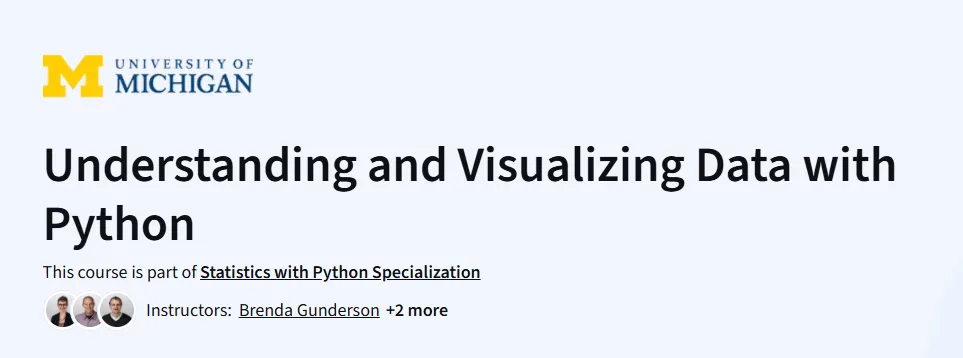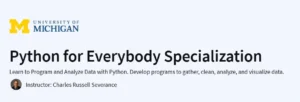What will you learn in Understanding and Visualizing Data with Python Course
Identify and understand different types of data (categorical, quantitative) and how they are collected.
Create data visualizations (histograms, bar charts, box plots, scatter plots) using Python.
Analyze multivariate relationships and apply numerical summaries for insight.
Explore sampling methods (probability vs non-probability) and learn how sample statistics infer population trends.
Program Overview
Module 1: Introduction to Data & Statistical Thinking
⏳ 1 week
• Topics: Data types, study design, introduction to Jupyter notebook environment
• Hands‑on: Work in labs on variable identification, Python basics, and notebook navigation
Module 2: Univariate Visualizations & Summaries
⏳ 1 week
• Topics: Bar charts, histograms, box plots, and basic numerical summaries like mean, median, IQR, standard score
• Hands‑on: Analyze and visualize univariate datasets using Python libraries such as Pandas and Matplotlib
Module 3: Multivariate Relationships & Association
⏳ 1 week
• Topics: Exploring relationships between quantitative and categorical variables, scatter plots, and correlation structures
• Hands‑on: Build multivariate visualizations and interpret patterns in real-world datasets
Module 4: Sampling, Inference & Interpretation
⏳ 1 week
• Topics: Probability vs non-probability sampling, sampling variability, interpreting statistical claims
• Hands‑on: Evaluate sample design examples and apply reasoning on how to generalize findings
Get certificate
Job Outlook
Core statistics skills and Python visualization are widely required in roles like Data Analyst, Research Associate, or BI Analyst.
Proficiency in tools like Pandas, Matplotlib, and Seaborn is valued in industries such as healthcare, finance, marketing, and academia.
Typical salary ranges: ₹6–12 LPA (India), $65K–$100K+ (global) for entry-level roles.
Builds a strong foundation for ML, data science, and decision-support roles.
Specification: Understanding and Visualizing Data with Python
|
FAQs
- Basic familiarity with Python is recommended but not mandatory.
- Focuses on hands-on data visualization using Pandas, Matplotlib, and Seaborn.
- Suitable for beginners in data analysis and statistics.
- Includes practical exercises using real-world datasets.
- Ideal for learners seeking to interpret and present data effectively.
- Covers univariate visualizations like histograms, bar charts, and box plots.
- Explores multivariate visualizations, including scatter plots and correlations.
- Teaches best practices for designing clear and interpretable charts.
- Includes hands-on exercises with Python libraries for real datasets.
- Prepares learners to communicate insights visually to stakeholders.
- Applicable for roles like Data Analyst, BI Analyst, or Research Associate.
- Builds foundation in Python-based data analysis workflows.
- Develops critical thinking for interpreting datasets accurately.
- Enhances employability in healthcare, finance, marketing, and academia.
- Prepares learners for advanced courses in machine learning and data science.
- Total duration: approximately 4 weeks (1 week per module).
- Self-paced learning allows flexible scheduling.
- Modules include introduction to data, univariate and multivariate visualizations, and sampling inference.
- Includes hands-on exercises in Jupyter Notebook environment.
- Suitable for learners aiming for structured, beginner-friendly data analysis practice.
- Learn numerical summaries like mean, median, interquartile range, and standard scores.
- Explore relationships between variables using correlations and scatter plots.
- Understand sampling methods and infer population trends.
- Apply statistical reasoning to real datasets through hands-on exercises.
- Skills directly transferable to practical data science and business analytics tasks.





